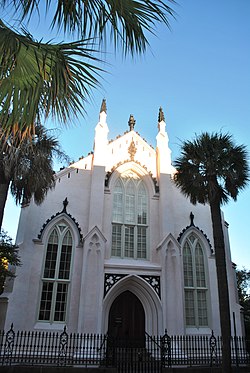French Huguenot Church
|
Huguenot Church
|
|

Huguenot Church
|
|
| Location | 136 Church St., Charleston, South Carolina |
|---|---|
| Coordinates | 32°46′42″N 79°55′45″W / 32.7782°N 79.9291°W |
| Built | 1844, consecrated 1845 |
| Architect | E. B. White (architect) |
| Architectural style | Gothic Revival |
| NRHP Reference # | 73001687 |
| Significant dates | |
| Added to NRHP | November 7, 1973 |
| Designated NHL | November 7, 1973 |
The Huguenot Church, also called the French Huguenot Church or the French Protestant Church, is a Gothic Revival church located at 136 Church Street in Charleston, South Carolina. Built in 1844 and designed by architect Edward Brickell White, it is the oldest Gothic Revival church in South Carolina, and has been designated a National Historic Landmark and listed on the National Register of Historic Places. The congregation it serves traces its origins to the 1680s, and is the only independent Huguenot church in the United States.
As Protestants in predominantly-Catholic France, Huguenots faced persecution throughout the 16th and 17th centuries. Following the Revocation of the Edict of Nantes in 1685, many Huguenots fled France for various parts of the world, including Charleston. The early congregation of Charleston's Huguenot Church included many of these refugees, and their descendants continued to play a role in the church's affairs for many decades. The church was originally affiliated with the Calvinist Reformed Church of France, and its doctrine still retains elements of Calvinist doctrine. The church's services still follow 18th century French liturgy, but are conducted in English.
The church is located in the area of Charleston known as the French Quarter, which was given this name in 1973 as part of preservation efforts. It recognizes that the area had a historically high concentration of French merchants.Peter Manigault, once the wealthiest man in the British North American colonies, is buried in the church cemetery.
The Huguenots, who were French Calvinists who faced suppression in France, began to settle in other areas in the sixteenth century, founding such failed colonies as Fort Caroline in Florida and Charlesfort in modern South Carolina, as well as settling in established areas, such as South Africa, Britain, and existing colonies such as New Netherlands and Virginia. In 1598, King Henry IV of France issued the Edict of Nantes, granting certain rights and protections to the Huguenots. This edict was revoked by Louis XIV in 1685, prompting a mass exodus of Huguenots from France.
...
Wikipedia


